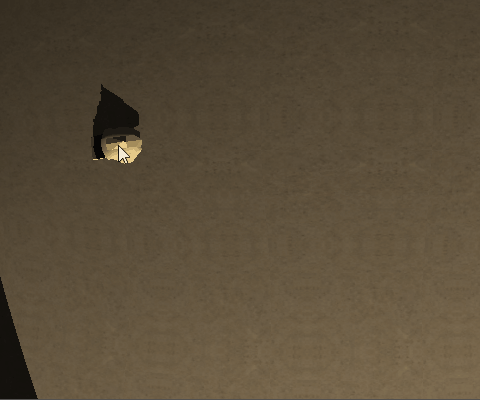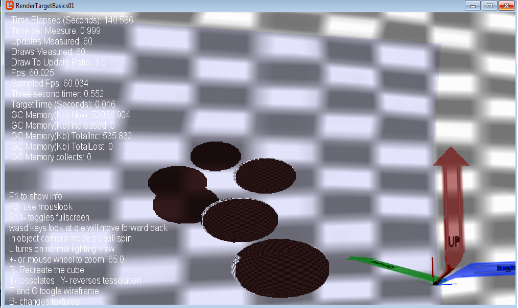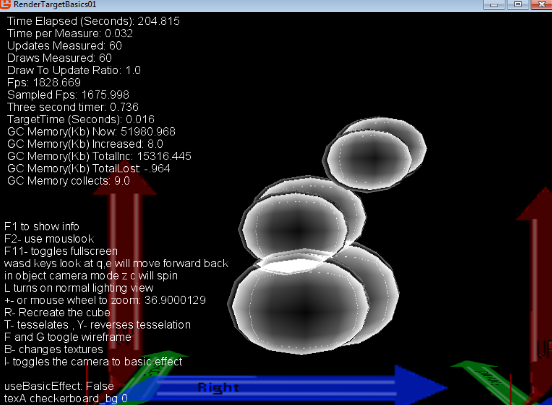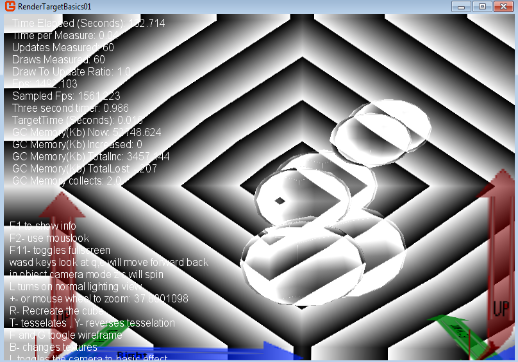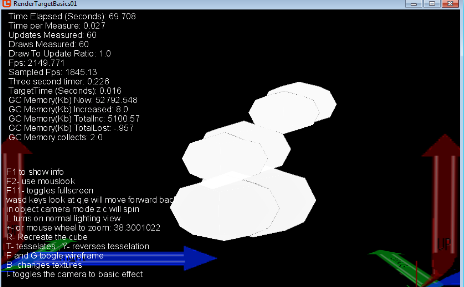Well the result is the opposite of what i would expect.
ill post a pic in a second.
Makes a shadow depth map simple enough
//_____________________________
//>>>>>>>>>shadowmap<<<<<<<<<<<
//_____________________________
//_____________________________
struct SMapVertexInput
{
float4 Position : POSITION0;
float2 TexCoords : TEXCOORD0;
};
struct SMapVertexToPixel
{
float4 Position : SV_Position;
float4 Position2D : TEXCOORD0;
};
struct SMapPixelToFrame
{
float4 Color : COLOR0;
};
float4 EncodeFloatRGBA(float v)
{
float4 kEncodeMul = float4(1.0, 255.0, 65025.0, 160581375.0);
float kEncodeBit = 1.0 / 255.0;
float4 enc = kEncodeMul * v;
enc = frac(enc);
enc -= enc.yzww * kEncodeBit;
return enc;
}
SMapVertexToPixel ShadowMapVertexShader(SMapVertexInput input)//(float4 inPos : POSITION)
{
SMapVertexToPixel Output;// = (SMapVertexToPixel)0;
Output.Position = mul(input.Position, lightsPovWorldViewProjection);
Output.Position2D = Output.Position;
return Output;
}
SMapPixelToFrame ShadowMapPixelShader(SMapVertexToPixel PSIn)
{
SMapPixelToFrame Output;// = (SMapPixelToFrame)0;
//Output.Color = PSIn.Position2D.z / PSIn.Position2D.w;
Output.Color = EncodeFloatRGBA(PSIn.Position2D.z / PSIn.Position2D.w);
return Output;
}
technique ShadowMap
{
pass Pass0
{
VertexShader = compile VS_SHADERMODEL ShadowMapVertexShader();
PixelShader = compile PS_SHADERMODEL ShadowMapPixelShader();
}
}
second part
//_______________________________________________________________
// >>>> LightingShadowPixelShader <<<
//_______________________________________________________________
struct VertexShaderLightingShadowInput
{
float4 Position : POSITION0;
float3 Normal : NORMAL0;
float4 Color : COLOR0;
float2 TexureCoordinateA : TEXCOORD0;
};
struct VertexShaderLightingShadowOutput
{
float4 Position : SV_Position;
float3 Normal : NORMAL0;
float4 Color : COLOR0;
float2 TexureCoordinateA : TEXCOORD0;
float4 Pos2DAsSeenByLight : TEXCOORD1;
float4 Position3D : TEXCOORD2;
};
struct PixelShaderLightingShadowOutput
{
float4 Color : COLOR0;
};
VertexShaderLightingShadowOutput VertexShaderLightingShadow(VertexShaderLightingShadowInput input)
{
VertexShaderLightingShadowOutput output;
output.Position = mul(input.Position, gworldviewprojection);
output.Pos2DAsSeenByLight = mul(input.Position, lightsPovWorldViewProjection);
output.Position3D = mul(input.Position, gworld);
output.Color = input.Color;
output.TexureCoordinateA = input.TexureCoordinateA;
output.Normal = input.Normal;
//output.Normal = normalize(mul(input.Normal, (float3x3)gworld));
return output;
}
PixelShaderLightingShadowOutput PixelShaderLightingShadow(VertexShaderLightingShadowOutput input)
{
PixelShaderLightingShadowOutput output;
float4 result = tex2D(TextureSamplerA, input.TexureCoordinateA);
// positional projection on depth map
float2 ProjectedTexCoords;
ProjectedTexCoords[0] = input.Pos2DAsSeenByLight.x / input.Pos2DAsSeenByLight.w / 2.0f + 0.5f;
ProjectedTexCoords[1] = -input.Pos2DAsSeenByLight.y / input.Pos2DAsSeenByLight.w / 2.0f + 0.5f;
// shadows depth map value
float depthStoredInShadowMap = DecodeFloatRGBA(tex2D(TextureSamplerB, ProjectedTexCoords));
// the real light distance
float realLightDepth = input.Pos2DAsSeenByLight.z / input.Pos2DAsSeenByLight.w;
// for testing
float4 inLightOrShadow = float4(.99f, .99f, .99f, 1.0f);
// if in bounds of the depth map
if ((saturate(ProjectedTexCoords).x == ProjectedTexCoords.x) && (saturate(ProjectedTexCoords).y == ProjectedTexCoords.y))
{
// in bounds slightly off color
inLightOrShadow = float4(.89f, .89f, .99f, 1.0f);
if ((realLightDepth - .1f) > depthStoredInShadowMap)
{
// shadow
inLightOrShadow = float4(0.20f, 0.10f, 0.10f, 1.0f);
}
}
// finalize
result *= inLightOrShadow;
result.a = 1.0f;
output.Color = result;
return output;
}
technique LightingShadowPixelShader
{
pass
{
VertexShader = compile VS_SHADERMODEL VertexShaderLightingShadow();
PixelShader = compile PS_SHADERMODEL PixelShaderLightingShadow();
}
}

i dunno i make my render target like this.
renderTargetDepth = new RenderTarget2D(GraphicsDevice, pp.BackBufferWidth, pp.BackBufferHeight, false, SurfaceFormat.Single , DepthFormat.Depth24);
my depth buffer is turned on.
protected override void Draw(GameTime gameTime)
{
GraphicsDevice.SetRenderTarget(renderTargetDepth);
//SetToDrawToRenderTarget(renderTarget1);
GraphicsDevice.Clear(ClearOptions.Target | ClearOptions.DepthBuffer, Color.Black, 1.0f, 0);
GraphicsDevice.DepthStencilState = ds_depthtest_lessthanequals;
GraphicsDevice.RasterizerState = selected_RS_State2;
DrawSphereCreateShadow(currentSkyBoxTexture, obj_sphere02, vertices_skybox, indices_skybox);
DrawSphereCreateShadow(currentSkyBoxTexture, obj_sphere03, vertices_skybox, indices_skybox);
DrawSphereCreateShadow(currentSkyBoxTexture, obj_sphere04, vertices_skybox, indices_skybox);
GraphicsDevice.SetRenderTarget(null);
GraphicsDevice.Clear(ClearOptions.Target | ClearOptions.DepthBuffer, Color.Black, 1.0f, 0);
GraphicsDevice.RasterizerState = rs_solid_ccw;
GraphicsDevice.DepthStencilState = ds_depthtest_lessthanequals;
DrawSphereAndShadow(skyBoxImageA, renderTargetDepth, obj_sky, vertices_skybox, indices_skybox);
GraphicsDevice.RasterizerState = rs_solid_cw;
DrawSphereAndShadow(skyBoxImageA, renderTargetDepth, obj_sphere02, vertices_skybox, indices_skybox);
DrawSphereAndShadow(skyBoxImageB, renderTargetDepth, obj_sphere03, vertices_skybox, indices_skybox);
DrawSphereAndShadow(skyBoxImageC, renderTargetDepth, obj_sphere04, vertices_skybox, indices_skybox);
GraphicsDevice.RasterizerState = RasterizerState.CullNone;
GraphicsDevice.BlendState = BlendState.AlphaBlend;
DrawOrientArrows(obj_CompassArrow);
DrawOrientArrows(obj_Light);
GraphicsDevice.BlendState = BlendState.Opaque;
//GraphicsDevice.RasterizerState = rs_solid_nocull;
//DrawScreenQuad((Texture2D)renderTarget1);
DrawText(gameTime);
base.Draw(gameTime);
}
my far plane is set at like 500 though.

